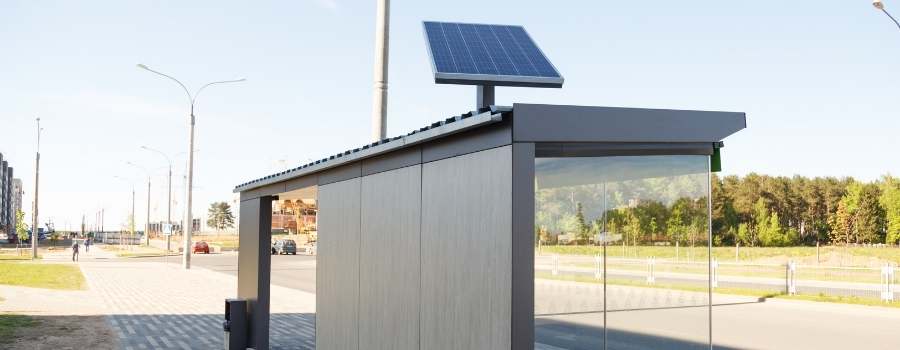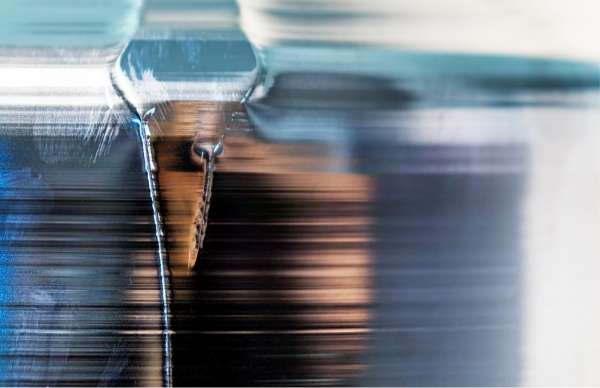
If you’re like me, then you probably started digging into solar panels for your home and ended up more confused than you started….every layer you peeled away just resulted in a dozen more layers.
Hopefully, a search for amorphous panels, also referred to as amorphous silicon solar panels, led you here since I’ve put together some info to help you out…long story short, you probably don’t need amorphous panels if you’re looking at a residential solar solution.
What Are Amorphous Solar Panels?
Amorphous solar panels are usually marketed as “thin-film” solar panels and are created in a different way than traditional solar cells. Manufacturers build them by depositing thin silicon layers directly onto a substrate, such as glass, metal, or plastic.
Since these panels don’t have cells, they also do not require the same physical connecting tabs that you’d find on a standard solar panel. Instead, manufacturers use a laser to pattern connections that carry electrical current.
Amorphous silicon solar panels are somewhat of a niche product. So, you’ll rarely find them on the roof of a home or building to generate electricity for widespread use.
Instead, you’ll find amorphous solar panels actively powering smaller appliances like:
- Pocket or desk calculators.
- Traffic or street lights.
- Buses or recreational vehicles, but only to power small appliances like fans.
Pros And Cons Of Amorphous Solar Panels
While not generally used in residential solar, amorphous solar panels come with their fair share of benefits…but, like any piece of technology, they also have some drawbacks. Here are a few that you’ll want to know:
Pros
- Very affordable – Amorphous solar panels use fewer materials with little or no wastage. That translates to a lighter price tag for buyers.
- Lightweight – They’re also incredibly light, making them easier to transport and mount on roofs and other surfaces.
- Flexible build – Thin-film panels aren’t rigid. So, they’re easier to shape and are less susceptible to physical damage.
- Heat-resistant – They are still efficient despite exposure to higher temperatures.
Cons
- Less Efficient – Despite their benefits, amorphous silicon solar panels are less efficient than standard types. So, you’ll require more of them to satisfy your power requirements.
- Requires More Space – Besides being inefficient in terms of power output, they’re also space-efficient. That’s because you’ll need more of them to satisfy your power needs compared to standard solar panels.
- Less Stable – Unlike rigid panels, flexible ones don’t always stay in place. Strong winds and other turbulent weather conditions can cause problems for these panels.
- Shorter Fifespan – All solar panels have a limited lifespan. Unfortunately, amorphous solar panels have the shortest among them.
Amorphous Solar Panel Efficiency
Typically, amorphous solar panels have an average efficiency of between 6% and 10% in terms of power generation. This is about a third of what you’d get from standard types.
The efficiency rating refers to a panel’s ability to convert solar energy into electricity. It is measured in terms of the percentage of sunlight that the panel absorbs and converts into usable power.
To put all of that into perspective, here are the efficiency ratings for standard solar panels:
- Polycrystalline panels: 15-18%
- Monocrystalline panels: 16.5% to 22%
Clearly, amorphous solar panels aren’t the top choice if your priority is efficiency in power generation.
On top of that, amorphous panels are also inefficient in terms of space. Remember: when you have solar panels that generate less energy, you’ll have to invest in more of them to satisfy your power needs.
So, you’ll use up more of your available space if you choose to go with amorphous solar panels. That’s why they’re more suitable for wide-open spaces and ground-mounting, instead of putting them on the roof of a building.
Suppose you have limited space. You’ll want to invest in panels with much higher efficiency, as those will take up less space overall.
Factors Influencing their Performance
Several factors influence the performance of amorphous solar panels, affecting their efficiency and overall output. Here are some key factors to consider:
- Sunlight Intensity and Angle: Amorphous solar panels are more tolerant to low light conditions and can generate electricity even in indirect sunlight. However, their performance can vary based on the angle and intensity of sunlight. Optimizing the positioning and orientation of panels can significantly impact their performance.
- Temperature: Like all solar panels, amorphous solar panels are affected by temperature. Higher temperatures can reduce their efficiency, causing a slight decline in power output. Manufacturers often provide temperature coefficients to help assess the panel’s performance under different temperature conditions.
- Panel Size and Configuration: The size and configuration of the amorphous solar panel array can influence its overall performance. The total surface area of the panels, the number of cells, and the arrangement of the panels in a system can impact the efficiency and power output.
Comparing Efficiency: Amorphous vs. Crystalline Solar Panels
Amorphous silicon solar panels generally have lower efficiency compared to crystalline solar panels. Crystalline solar panels, which include monocrystalline and polycrystalline panels, are known for their higher efficiency due to the crystalline structure of their cells.
However, you need to consider the broader context when comparing efficiency. Amorphous solar panels have certain advantages that make them suitable for specific applications.
They have a lower manufacturing cost, flexibility, and better performance in low light conditions. Crystalline solar panels, on the other hand, excel in high-light conditions and have a longer lifespan.

Monocrystalline vs. Amorphous Solar Panels
Monocrystalline panels, known for their high efficiency and durability, are made from a single, continuous crystal structure, giving them a characteristic uniform, dark look.
In contrast, amorphous solar panels, often more affordable and flexible, are made from non-crystalline silicon spread over a substrate like glass or metal. These panels are thinner and less efficient but better at performing in low-light conditions.
Amorphous solar panels are still somewhat a niche, and they’re certainly not the only option available on the market today. However, those panels stand alongside other solar panels that come in 4 different types:
- Monocrystalline panels
- Polycrystalline panels
- Passivated Emitter
- Rear Cell (PERC) panels
Monocrystalline Solar Panels
The term ‘mono’ in the name tells you most of what you need to know about these solar panels. Also known as single-crystal panels, manufacturers take one pure silicon crystal, turn it into bars, and then cut it into several thin wafers.
The manufacturing process for this type of solar panel wastes a lot of silicon. Unfortunately, that means monocrystalline solar panels are more expensive than other options.
Monocrystalline solar panels have the most extended lifespan, and they have a higher energy output per panel. That means you’ll use less space to produce the same amount of power compared to other panel types.
Visually, you can recognize monocrystalline solar panels from afar. That’s because the cells have a signature black color that other kinds of solar panels do not have.
Polycrystalline Solar Panels
Polycrystalline solar panels are more affordable than their ‘mono’ counterpart. That’s because the production process results in little or no wastage.
Manufacturers take several silicon crystal fragments to make these panels and melt them down. Then, they pour all of it into a square mold, with almost none of the silicon going to waste.
As a result, these panels are more affordable compared to the monocrystalline type. Naturally, there’s a trade-off.
Polycrystalline solar panels don’t last as long and aren’t as good at tolerating high temperatures.
Plus, they’re less efficient at producing electricity, which means you’ll need more of them to fulfill your energy needs.
PERC Solar Panels (Passive Emitter and Rear Cell)
Passivated Emitter and Rear Cell (PERC) panels are newer, more improved, and upgraded monocrystalline panels. Here’s why:
PERC panels take a monocrystalline panel and add a ‘passivation’ layer behind the solar cells. That layer reflects light back into the solar cell after it passes through the first time around. That means the solar cell has a chance to capture even more sunlight to convert to electricity.
Also, the passivation layer also reflects the kinds of light that the solar cells won’t absorb. You see, solar cells can’t absorb light that’s above a particular wavelength. That light typically passes through and converts to heat that raises the panel’s temperature and makes it less efficient.
By reflecting that unabsorbed light away from the solar panel, the passivation layer helps to keep the solar panel cool and, therefore, more efficient.
As you can see, PERC solar panels are much more efficient at capturing sunlight and converting it to electricity. That’s excellent news for another crucial reason: it also means you’ll need fewer solar panels to satisfy your energy needs.
Applications and Uses
Residential Applications
Amorphous solar panels offer various applications and benefits for residential use. Here are some key areas where they can be effectively employed:
- Rooftop Installations: Amorphous solar panels can be mounted on residential rooftops, providing a clean and sustainable energy solution. Their flexibility allows for easier integration into different roof designs, including curved or non-standard shapes.
- Solar Water Heating: Amorphous silicon solar panels can be utilized for solar water heating systems in residential properties. These panels absorb sunlight and convert it into thermal energy, which is used to heat water for domestic use, reducing reliance on traditional water heating methods.
- Outdoor Lighting and Landscaping: Amorphous solar panels can power outdoor lighting fixtures, such as garden lights and pathway illumination. They can also be used to run pumps for fountains or small water features in residential landscapes.
Commercial and Industrial Uses
Amorphous solar panels also find practical applications in commercial and industrial settings. Here are a few examples of how they can be utilized:
- Building Integration: Amorphous solar panels can be integrated into the facades or windows of commercial buildings, generating clean energy while providing shade and reducing cooling costs. This approach is known as Building Integrated Photovoltaics (BIPV) and offers both functional and aesthetic benefits.
- Large-Scale Solar Installations: Amorphous solar panels can be deployed in utility-scale solar projects, including solar farms and power plants. Their lower manufacturing cost and tolerance to low light conditions make them suitable for large-scale installations in areas with varying weather patterns.
- Off-Grid Electrification: In remote areas or regions with limited access to electricity, amorphous solar panels can be used to provide power for commercial and industrial applications. This includes powering telecommunications equipment, remote monitoring systems, or small-scale manufacturing operations.
Off-Grid and Portable Solutions
Amorphous solar panels are well-suited for off-grid and portable applications, offering flexibility and independence from traditional power sources. Here are some notable uses:
- Camping and RVs: Amorphous solar panels can be used to charge batteries in camping sites or RVs, providing a reliable source of electricity for lighting, cooking appliances, and other electronic devices.
- Outdoor Events and Festivals: Amorphous solar panels can power temporary installations at outdoor events and festivals. They can be used to generate electricity for lighting stages, charging stations for attendees, or running sound systems.
- Emergency Power Backup: Amorphous solar panels can serve as a backup power solution during emergencies or power outages. They can charge batteries or directly power essential devices like emergency lights, communication equipment, or medical devices.
Final Thoughts
So, amorphous solar panels serve an important purpose in the grand scope of solar energy, but they aren’t designed for residential solar…so there is one less thing you need to worry about when deciding on which way to go.
When it comes down to deciding on which solar panel type is best for your needs, you need to consider different factors. Of course, the initial cost of each option is an important factor, but that’s not everything there is to know.
Consider how long each type will last and how efficient they are at producing power first. Then, consult a solar energy expert in your area to help you make the final decision.

